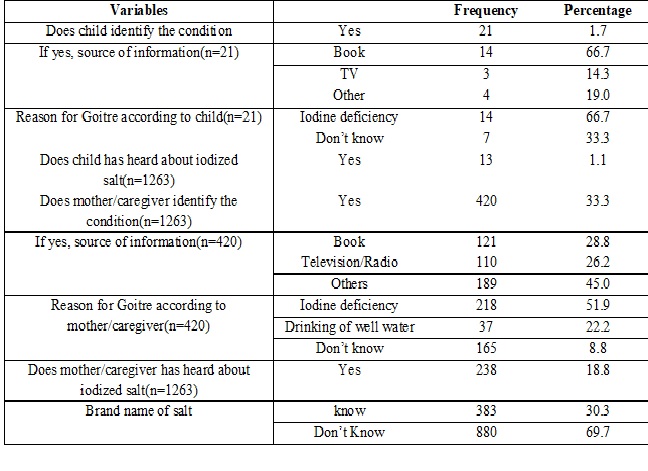Knowledge and practices regarding use of iodised salt among population ofselected goitre endemic districts of Bihar
Abstract
Background:Iodine deficiency disorders (IDDs) are important public health problem which can be prevented by consumption of iodized salt. For sustainable elimination of IDDs, the goal of universal salt iodization (USI) is to cover more than 90% of household to consume adequately iodized salt. This study was conducted with objectives to assess knowledge and practices regarding salt consumption and to find the factors associated with consumption of adequately iodized salt in selected districts of traditional goitre belt of Bihar.
Materials and Methods: The study was a community based cross-sectional study conducted in three districts of Bihar by using cluster sampling technique from January 2018 to March 2018.
Results: Only 1.7% children and 33% adults were able to identify the condition of goitre. Among adults who identified the case as goitre, around 52% respondents had correct knowledge about cause of goitre. Around 30% caregivers knew the brand name of salt that was used in their household and only 19% of adults had heard about iodized salt.In around 13% households; salt was added at the end of cooking during food preparation. Adequately iodized salt was consumed in 73.5% households. The salt stored in air tight container had significantly higher iodine content in comparison to salt stored in open container (p=0.041).
Conclusion: The knowledge among people regarding IDDs and iodized salt was very poor which need to be focused in our national programme. The goal of USI regarding iodized salt consumption is yet to be achieved in these districts.
Downloads
References
2. Global health risks: mortality and burden of disease attributable to selected major risks. Geneva: World Health Organization; 2009 (http://www.who.int/healthinfo/global_burden_disease/GlobalHealthRisks_report_full.pdf, accessed 23 October 2014).
3. Iodine status worldwide. WHO global database on iodine deficiency. Geneva: World Health Organization; 2004(http://whqlibdoc.who.int/publications/2004/9241592001.pdf?q=iodine-status-worldwide, accessed 27 June 2018).
4. de Benoist B, McLean E, Andersson M, Rogers L. Iodine deficiency in 2007: global progress since 2003. Food NutrBull. 2008;29(3):195–202.[pubmed]
5. WHO/ICCIDD/UNICEF. Assessment of Iodine Deficiency Disorders and monitoring their elimination: A guide for programme managers. Geneva: World Health Organization;2007.p.73-5.
Available from:http://www.whqlibdoc.who.int/publications/2007/9789241595827_eng.pdf (Accessed on June 8, 2018)
6. UNICEF, Sustainable Elimination of Iodine Deficiency: Progress Since the 1990World Summit for Children, 2008.
7. International council for control of iodine deficiency disorders.IDD newsletter, May 2011, India, Vol. 39(2)
8. Kumma WP, Haji Y, Abdurahmen J, Adinew YM. Factors Affecting the Presence of Adequately Iodized Salt at Home in Wolaita, Southern Ethiopia: Community Based Study. International Journal of Food Science, Volume 2018; P1-9.[pubmed]
9. Pandav CS, Yadav K, Srivastava R, Pandav R, Karmarkar MG. Iodine deficiency disorders (IDD) control in India. Indian journal of medical research. 2013 Sep;138(3):418-433.
10. Singh T, Sharma S, Nagesh S. Socio-economic status scales updated for 2017. International Journal of Research in Medical Sciences 2017;5:3264-7
11. Roy R, Chaturvedi M, Agrawal D, Ali H. Household use of iodized salt in rural area. Journal of Family Medicine and Primary Care 2016;5:77-81.[pubmed]
12. Sen TK, Das DK, Biswas AB, Chakrabarty I, Mukhopadhyay S, Roy R. Limited access to iodized salt among the poor and disadvantaged in North 24 Parganas district of West Bengal, India. J Health PopulNutr2010;28:369‑74.[pubmed]
13. National Family Health Survey 4(NFHS 4) 2015-16 Available athttp://rchiips.org/NFHS/NFHS-4Reports/Bihar.pdf. last accessed on 5 june 2018.
14. Kapil U, PrakashS, Nayar D. Study of some factorsinfluencing losses of iodine from iodised salt. Indian Journalof Maternal and Child Health, 1998,vol. 9, no. 1, pp. 46-47.
15. Waszkowiak K, Szymandera K. Effect of storage conditionson potassium iodide stability in iodised table salt andcollagen preparations. International Journal of Food Science &Technology,2008; vol. 43, no. 5, pp. 895–899.

Copyright (c) 2018 Author (s). Published by Siddharth Health Research and Social Welfare Society

This work is licensed under a Creative Commons Attribution 4.0 International License.


 OAI - Open Archives Initiative
OAI - Open Archives Initiative


